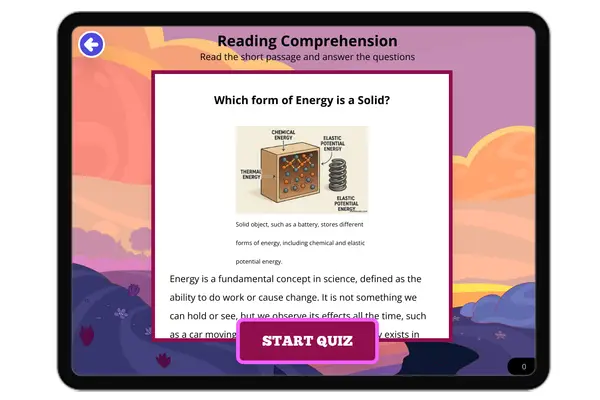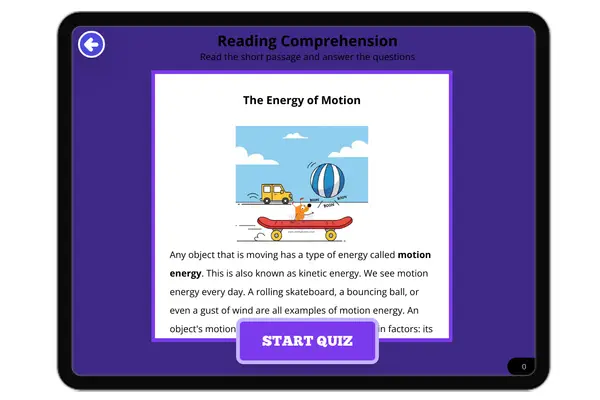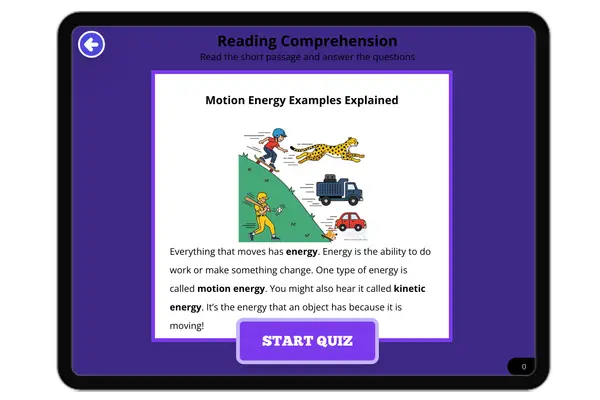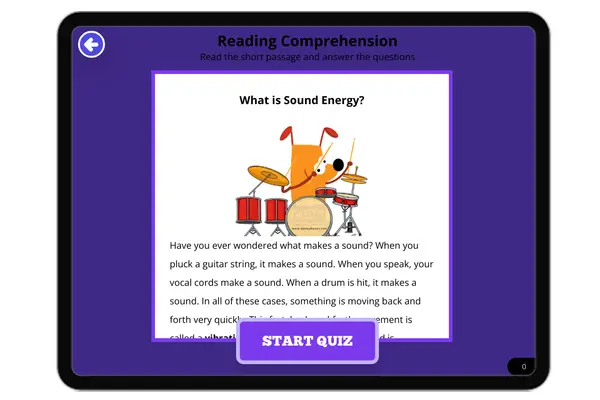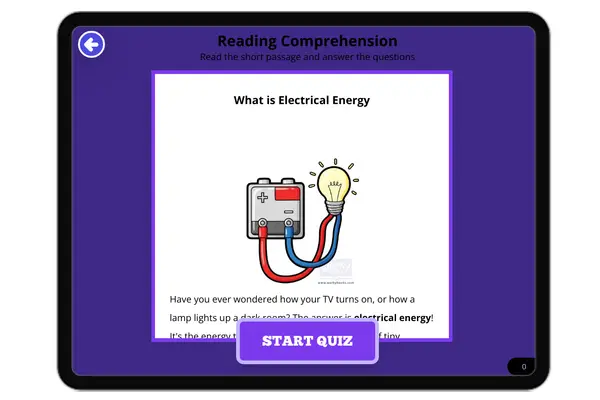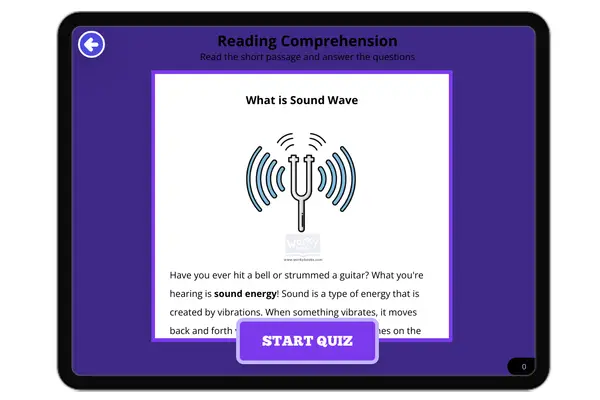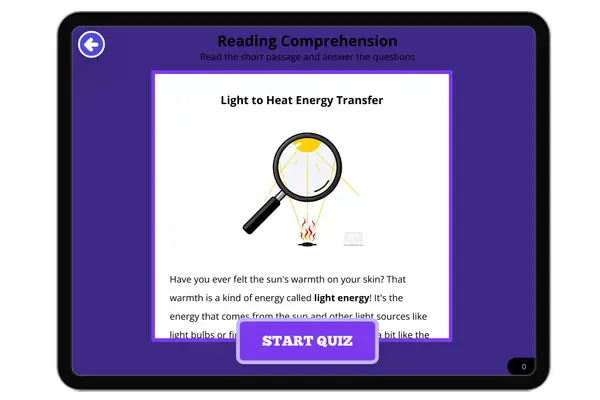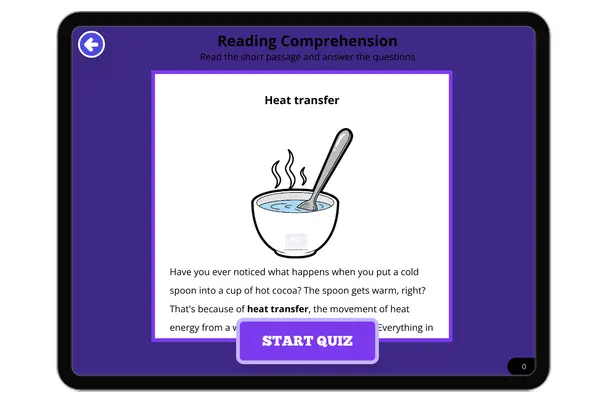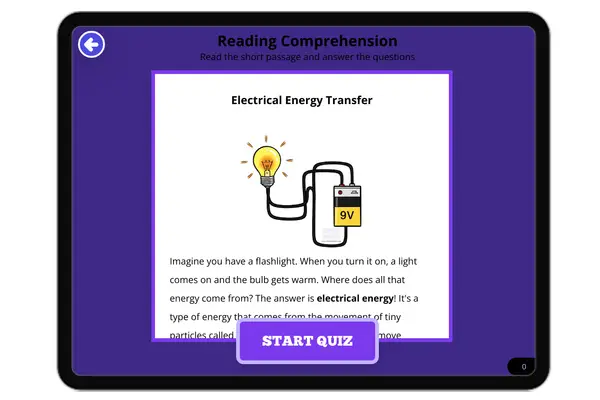Observing Sunlight and Heat
This reading passage introduces children to the concept of how sunlight affects Earth’s surfaces. Using a relatable stor...
K-PS3-1RL.1.1
Warmth from the Sun
This reading passage tells the story of Liam at the beach, exploring how sunlight affects the temperature of rocks, sand...
K-PS3-1RL.1.1
Building Shade Structures
In this passage, Alex and Mia use a simple tent to block sunlight and create a cooler place to play. By observing the ef...
K-PS3-1RL.1.1
Shade from the Sun
In this story, Leo and Emma use an umbrella to block the sunlight and stay cool while playing in the park. By observing ...
K-PS3-1RL.1.1
The Hot Slide
This passage explores NGSS K-PS3-1 through familiar playground experiences. Students observe how sunlight affects differ...
K-PS3-1RL.1.1
Beach Day Science
This passage addresses NGSS K-PS3-1 by comparing temperature differences in materials exposed to sunlight versus shade. ...
K-PS3-1RL.1.1
The Sun Shelter
This passage addresses NGSS K-PS3-2 through a practical experiment with sun shelters. Students learn how designed struct...
K-PS3-2RL.1.1
Maria's Cool Shade Idea
This passage supports NGSS K-PS3-2 learning by showing how simple structures can protect plants from sun damage. Through...
K-PS3-2RL.1.1
Energy Transfer in Collisions
This grade 4 activity encourages students to ask questions and predict outcomes about energy changes during collisions. ...
Energy Conversion Devices
This engaging activity helps grade 4 students explore energy conversion through real-world devices. Students match devic...
Energy on the Move
This grade 4 activity focuses on recognizing energy transfer processes. Students categorize examples such as 'thundercla...
Energy in Collisions
This activity for grade 4 students explores energy changes during collisions. Students categorize scenarios like 'bumper...
How Does Energy Travel?
This interactive activity for grade 4 students explores how energy transfers through sound, light, heat, and electric cu...
Motion and Energy Examples
This activity focuses on the relationship between motion and energy for grade 4 students. By matching terms such as 'rac...
Understanding Specific Heat
This passage, 'Understanding Specific Heat,' explains the concept of specific heat to middle school students in an acces...
MS-PS3HS-PS3RI.6.3RI.7.1
The Specific Heat of Copper
This middle school reading passage, 'The Specific Heat of Copper,' explores how copper responds to heat due to its low s...
MS-PS3HS-PS3RI.6.3RI.7.1
The Specific Heat Capacity of Water
This middle school science reading passage, 'The Specific Heat Capacity of Water,' explains how water's high specific he...
MS-PS3HS-PS3RI.6.3RI.7.1
The Specific Heat of Ice
This middle school science passage, 'The Specific Heat of Ice,' explains how ice has a lower specific heat than liquid w...
MS-PS3HS-PS3RI.6.3RI.7.1
What Is Thermal Energy?
This middle school science passage, 'What Is Thermal Energy?', introduces students to the concept of energy from particl...
MS-PS3HS-PS3RI.6.3RI.7.1
What Is the Difference Between Thermal Energy and Heat?
This passage, 'What Is the Difference Between Thermal Energy and Heat?', helps middle school students understand the key...
MS-PS3HS-PS3RI.6.3RI.7.1
How Does Heat Move?
This engaging middle school science passage introduces students to the basic principles of heat transfer, aligning with ...
MS-PS3HS-PS3RI.6.3RI.7.1
What Is Conduction?
This middle school science passage explains the concept of conduction, focusing on how heat moves through solids. Aligne...
MS-PS3HS-PS3RI.6.3RI.7.1
What Is Conductivity?
This middle school science reading passage introduces students to the concept of conductivity, explaining how materials ...
MS-PS3HS-PS3RI.6.3RI.7.1
What Is an Example of Conduction?
This middle school science reading passage explains conduction through everyday examples, such as a hot metal spoon in s...
MS-PS3HS-PS3RI.6.3RI.7.1
What Is a Temperature Gradient?
This engaging science passage introduces students to the concept of a temperature gradient, a key idea aligned with the ...
MS-PS3HS-PS3RI.6.3RI.7.1
Heat Transfer Rate
This passage introduces students to the concept of heat transfer rate, aligned with NGSS standard MS-PS3-3. It explains ...
MS-PS3HS-PS3RI.6.3RI.7.1
What Is Entropy in Energy?
This passage introduces the concept of entropy in the context of energy, aligning with NGSS standard MS-PS3-4. It explai...
MS-PS3HS-PS3RI.6.3RI.7.1
What Is an Endothermic Reaction?
This engaging science passage introduces middle school readers to the concept of endothermic reactions, aligned with NGS...
MS-PS3-44-PS3-34-PS3-2
What Is an Exothermic Reaction?
This science passage introduces students to the idea of exothermic reactions—chemical changes that release heat or light...
MS-PS3-44-PS3-34-PS3-2
Is Freezing Endothermic or Exothermic?
This clear and accessible passage helps students understand why freezing is an exothermic process, even though frozen ob...
MS-PS3-44-PS3-34-PS3-2
What Is Gravitational Energy?
This engaging science passage for middle school students explores the concept of gravitational energy, a form of potenti...
MS-PS3-44-PS3-34-PS3-2
What Is Kinetic Energy?
This NGSS-aligned reading passage introduces 6th–8th grade students to the concept of kinetic energy—energy that an obje...
MS-PS3-44-PS3-34-PS3-2
Understanding Mechanical Energy
This science passage is crafted for 6th–8th grade students and focuses on mechanical energy—specifically the combination...
MS-PS3-44-PS3-34-PS3-2
Chemical Energy
This informational science passage on chemical energy is designed for middle school students and aligns with the NGSS st...
MS-PS3-44-PS3-34-PS3-2
Energy Transfer
This NGSS-aligned science passage introduces middle school students to the concept of energy transfer, aligned to standa...
MS-PS3-5
Energy Transformation
This middle school science passage aligned to NGSS standard MS-PS3-5 explains the concept of energy transformation—the p...
MS-PS3-5
Joule – The Unit of Energy
This NGSS-aligned reading passage introduces students to the joule, the standard unit of energy in the metric system, an...
MS-PS3-5
Work – A Scientific Definition
This NGSS-aligned science passage explains the definition of work as used in physical science and supports standard MS-P...
MS-PS3-5
Newton (N) – The Unit of Force
This NGSS-aligned passage introduces middle school students to the newton (N), the standard unit of force in the metric ...
MS-PS3-5
Which form of Energy is a Solid?
This science passage for middle school students explores the core concepts of energy, defining it as the ability to do w...
Motion Energy
This NGSS-aligned science passage for 4th graders focuses on the disciplinary core concept of Motion Energy (PS1.A). It'...
Motion Energy Examples Explained
This science passage is designed for a 4th-grade audience and aligns with NGSS standards, specifically addressing the di...
Sound Energy
This engaging science passage, titled "What is Sound Energy?", is designed for 4th-grade students and aligns with the NG...
Light Energy
This science passage is specifically designed to meet the Next Generation Science Standards (NGSS) for 4th grade, focusi...
Heat Energy
This 4th-grade science passage explores the concept of heat energy, a key topic in the NGSS standards. Students will lea...
Electrical Energy
This 4th-grade science passage explores the concept of electrical energy, a core topic in the NGSS standards. Students w...
Sound Waves
This 4th-grade science passage explores the concept of sound energy, a key topic in the NGSS standards. Students will le...
Light to Heat Energy
This 4th-grade science passage explores the concept of light energy, a key topic in the NGSS standards. Students will le...
Heat Transfer
This 4th-grade science passage explores the concept of heat transfer, a key topic in the NGSS standards. Students will l...











































